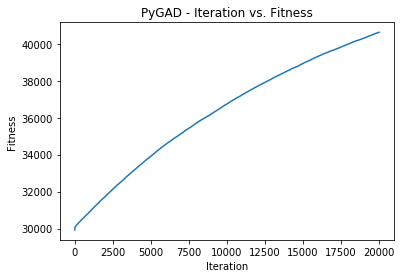pygad Module¶
This section of the PyGAD’s library documentation discusses the
pygad module.
Using the pygad module, instances of the genetic algorithm can be
created, run, saved, and loaded. Single-objective and multi-objective
optimization problems can be solved.
pygad.GA Class¶
The first module available in PyGAD is named pygad and contains a
class named GA for building the genetic algorithm. The constructor,
methods, function, and attributes within the class are discussed in this
section.
__init__()¶
For creating an instance of the pygad.GA class, the constructor
accepts several parameters that allow the user to customize the genetic
algorithm to different types of applications.
The pygad.GA class constructor supports the following parameters:
num_generations: Number of generations.num_parents_mating: Number of solutions to be selected as parents.fitness_func: Accepts a function/method and returns the fitness value(s) of the solution. If a function is passed, then it must accept 3 parameters (1. the instance of thepygad.GAclass, 2. a single solution, and 3. its index in the population). If method, then it accepts a fourth parameter representing the method’s class instance. Check the Preparing the fitness_func Parameter section for information about creating such a function. In PyGAD 3.2.0, multi-objective optimization is supported. To consider the problem as multi-objective, just return alist,tuple, ornumpy.ndarrayfrom the fitness function.fitness_batch_size=None: A new optional parameter calledfitness_batch_sizeis supported to calculate the fitness function in batches. If it is assigned the value1orNone(default), then the normal flow is used where the fitness function is called for each individual solution. If thefitness_batch_sizeparameter is assigned a value satisfying this condition1 < fitness_batch_size <= sol_per_pop, then the solutions are grouped into batches of sizefitness_batch_sizeand the fitness function is called once for each batch. Check the Batch Fitness Calculation section for more details and examples. Added in from PyGAD 2.19.0.initial_population: A user-defined initial population. It is useful when the user wants to start the generations with a custom initial population. It defaults toNonewhich means no initial population is specified by the user. In this case, PyGAD creates an initial population using thesol_per_popandnum_genesparameters. An exception is raised if theinitial_populationisNonewhile any of the 2 parameters (sol_per_popornum_genes) is alsoNone. Introduced in PyGAD 2.0.0 and higher.sol_per_pop: Number of solutions (i.e. chromosomes) within the population. This parameter has no action ifinitial_populationparameter exists.num_genes: Number of genes in the solution/chromosome. This parameter is not needed if the user feeds the initial population to theinitial_populationparameter.gene_type=float: Controls the gene type. It can be assigned to a single data type that is applied to all genes or can specify the data type of each individual gene. It defaults tofloatwhich means all genes are offloatdata type. Starting from PyGAD 2.9.0, thegene_typeparameter can be assigned to a numeric value of any of these types:int,float, andnumpy.int/uint/float(8-64). Starting from PyGAD 2.14.0, it can be assigned to alist,tuple, or anumpy.ndarraywhich hold a data type for each gene (e.g.gene_type=[int, float, numpy.int8]). This helps to control the data type of each individual gene. In PyGAD 2.15.0, a precision for thefloatdata types can be specified (e.g.gene_type=[float, 2].init_range_low=-4: The lower value of the random range from which the gene values in the initial population are selected.init_range_lowdefaults to-4. Available in PyGAD 1.0.20 and higher. This parameter has no action if theinitial_populationparameter exists.init_range_high=4: The upper value of the random range from which the gene values in the initial population are selected.init_range_highdefaults to+4. Available in PyGAD 1.0.20 and higher. This parameter has no action if theinitial_populationparameter exists.parent_selection_type="sss": The parent selection type. Supported types aresss(for steady-state selection),rws(for roulette wheel selection),sus(for stochastic universal selection),rank(for rank selection),random(for random selection), andtournament(for tournament selection). A custom parent selection function can be passed starting from PyGAD 2.16.0. Check the User-Defined Crossover, Mutation, and Parent Selection Operators section for more details about building a user-defined parent selection function.keep_parents=-1: Number of parents to keep in the current population.-1(default) means to keep all parents in the next population.0means keep no parents in the next population. A valuegreater than 0means keeps the specified number of parents in the next population. Note that the value assigned tokeep_parentscannot be< - 1or greater than the number of solutions within the populationsol_per_pop. Starting from PyGAD 2.18.0, this parameter have an effect only when thekeep_elitismparameter is0. Starting from PyGAD 2.20.0, the parents’ fitness from the last generation will not be re-used ifkeep_parents=0.keep_elitism=1: Added in PyGAD 2.18.0. It can take the value0or a positive integer that satisfies (0 <= keep_elitism <= sol_per_pop). It defaults to1which means only the best solution in the current generation is kept in the next generation. If assigned0, this means it has no effect. If assigned a positive integerK, then the bestKsolutions are kept in the next generation. It cannot be assigned a value greater than the value assigned to thesol_per_popparameter. If this parameter has a value different than0, then thekeep_parentsparameter will have no effect.K_tournament=3: In case that the parent selection type istournament, theK_tournamentspecifies the number of parents participating in the tournament selection. It defaults to3.crossover_type="single_point": Type of the crossover operation. Supported types aresingle_point(for single-point crossover),two_points(for two points crossover),uniform(for uniform crossover), andscattered(for scattered crossover). Scattered crossover is supported from PyGAD 2.9.0 and higher. It defaults tosingle_point. A custom crossover function can be passed starting from PyGAD 2.16.0. Check the User-Defined Crossover, Mutation, and Parent Selection Operators section for more details about creating a user-defined crossover function. Starting from PyGAD 2.2.2 and higher, ifcrossover_type=None, then the crossover step is bypassed which means no crossover is applied and thus no offspring will be created in the next generations. The next generation will use the solutions in the current population.crossover_probability=None: The probability of selecting a parent for applying the crossover operation. Its value must be between 0.0 and 1.0 inclusive. For each parent, a random value between 0.0 and 1.0 is generated. If this random value is less than or equal to the value assigned to thecrossover_probabilityparameter, then the parent is selected. Added in PyGAD 2.5.0 and higher.mutation_type="random": Type of the mutation operation. Supported types arerandom(for random mutation),swap(for swap mutation),inversion(for inversion mutation),scramble(for scramble mutation), andadaptive(for adaptive mutation). It defaults torandom. A custom mutation function can be passed starting from PyGAD 2.16.0. Check the User-Defined Crossover, Mutation, and Parent Selection Operators section for more details about creating a user-defined mutation function. Starting from PyGAD 2.2.2 and higher, ifmutation_type=None, then the mutation step is bypassed which means no mutation is applied and thus no changes are applied to the offspring created using the crossover operation. The offspring will be used unchanged in the next generation.Adaptivemutation is supported starting from PyGAD 2.10.0. For more information about adaptive mutation, go the the Adaptive Mutation section. For example about using adaptive mutation, check the Use Adaptive Mutation in PyGAD section.mutation_probability=None: The probability of selecting a gene for applying the mutation operation. Its value must be between 0.0 and 1.0 inclusive. For each gene in a solution, a random value between 0.0 and 1.0 is generated. If this random value is less than or equal to the value assigned to themutation_probabilityparameter, then the gene is selected. If this parameter exists, then there is no need for the 2 parametersmutation_percent_genesandmutation_num_genes. Added in PyGAD 2.5.0 and higher.mutation_by_replacement=False: An optional bool parameter. It works only when the selected type of mutation is random (mutation_type="random"). In this case,mutation_by_replacement=Truemeans replace the gene by the randomly generated value. If False, then it has no effect and random mutation works by adding the random value to the gene. Supported in PyGAD 2.2.2 and higher. Check the changes in PyGAD 2.2.2 under the Release History section for an example.mutation_percent_genes="default": Percentage of genes to mutate. It defaults to the string"default"which is later translated into the integer10which means 10% of the genes will be mutated. It must be>0and<=100. Out of this percentage, the number of genes to mutate is deduced which is assigned to themutation_num_genesparameter. Themutation_percent_genesparameter has no action ifmutation_probabilityormutation_num_genesexist. Starting from PyGAD 2.2.2 and higher, this parameter has no action ifmutation_typeisNone.mutation_num_genes=None: Number of genes to mutate which defaults toNonemeaning that no number is specified. Themutation_num_genesparameter has no action if the parametermutation_probabilityexists. Starting from PyGAD 2.2.2 and higher, this parameter has no action ifmutation_typeisNone.random_mutation_min_val=-1.0: Forrandommutation, therandom_mutation_min_valparameter specifies the start value of the range from which a random value is selected to be added to the gene. It defaults to-1. Starting from PyGAD 2.2.2 and higher, this parameter has no action ifmutation_typeisNone.random_mutation_max_val=1.0: Forrandommutation, therandom_mutation_max_valparameter specifies the end value of the range from which a random value is selected to be added to the gene. It defaults to+1. Starting from PyGAD 2.2.2 and higher, this parameter has no action ifmutation_typeisNone.gene_space=None: It is used to specify the possible values for each gene in case the user wants to restrict the gene values. It is useful if the gene space is restricted to a certain range or to discrete values. It accepts alist,range, ornumpy.ndarray. When all genes have the same global space, specify their values as alist/tuple/range/numpy.ndarray. For example,gene_space = [0.3, 5.2, -4, 8]restricts the gene values to the 4 specified values. If each gene has its own space, then thegene_spaceparameter can be nested like[[0.4, -5], [0.5, -3.2, 8.2, -9], ...]where the first sublist determines the values for the first gene, the second sublist for the second gene, and so on. If the nested list/tuple has aNonevalue, then the gene’s initial value is selected randomly from the range specified by the 2 parametersinit_range_lowandinit_range_highand its mutation value is selected randomly from the range specified by the 2 parametersrandom_mutation_min_valandrandom_mutation_max_val.gene_spaceis added in PyGAD 2.5.0. Check the Release History of PyGAD 2.5.0 section of the documentation for more details. In PyGAD 2.9.0, NumPy arrays can be assigned to thegene_spaceparameter. In PyGAD 2.11.0, thegene_spaceparameter itself or any of its elements can be assigned to a dictionary to specify the lower and upper limits of the genes. For example,{'low': 2, 'high': 4}means the minimum and maximum values are 2 and 4, respectively. In PyGAD 2.15.0, a new key called"step"is supported to specify the step of moving from the start to the end of the range specified by the 2 existing keys"low"and"high".on_start=None: Accepts a function/method to be called only once before the genetic algorithm starts its evolution. If function, then it must accept a single parameter representing the instance of the genetic algorithm. If method, then it must accept 2 parameters where the second one refers to the method’s object. Added in PyGAD 2.6.0.on_fitness=None: Accepts a function/method to be called after calculating the fitness values of all solutions in the population. If function, then it must accept 2 parameters: 1) a list of all solutions’ fitness values 2) the instance of the genetic algorithm. If method, then it must accept 3 parameters where the third one refers to the method’s object. Added in PyGAD 2.6.0.on_parents=None: Accepts a function/method to be called after selecting the parents that mates. If function, then it must accept 2 parameters: 1) the selected parents 2) the instance of the genetic algorithm If method, then it must accept 3 parameters where the third one refers to the method’s object. Added in PyGAD 2.6.0.on_crossover=None: Accepts a function to be called each time the crossover operation is applied. This function must accept 2 parameters: the first one represents the instance of the genetic algorithm and the second one represents the offspring generated using crossover. Added in PyGAD 2.6.0.on_mutation=None: Accepts a function to be called each time the mutation operation is applied. This function must accept 2 parameters: the first one represents the instance of the genetic algorithm and the second one represents the offspring after applying the mutation. Added in PyGAD 2.6.0.on_generation=None: Accepts a function to be called after each generation. This function must accept a single parameter representing the instance of the genetic algorithm. If the function returned the stringstop, then therun()method stops without completing the other generations. Added in PyGAD 2.6.0.on_stop=None: Accepts a function to be called only once exactly before the genetic algorithm stops or when it completes all the generations. This function must accept 2 parameters: the first one represents the instance of the genetic algorithm and the second one is a list of fitness values of the last population’s solutions. Added in PyGAD 2.6.0.delay_after_gen=0.0: It accepts a non-negative number specifying the time in seconds to wait after a generation completes and before going to the next generation. It defaults to0.0which means no delay after the generation. Available in PyGAD 2.4.0 and higher.save_best_solutions=False: WhenTrue, then the best solution after each generation is saved into an attribute namedbest_solutions. IfFalse(default), then no solutions are saved and thebest_solutionsattribute will be empty. Supported in PyGAD 2.9.0.save_solutions=False: IfTrue, then all solutions in each generation are appended into an attribute calledsolutionswhich is NumPy array. Supported in PyGAD 2.15.0.suppress_warnings=False: A bool parameter to control whether the warning messages are printed or not. It defaults toFalse.allow_duplicate_genes=True: Added in PyGAD 2.13.0. IfTrue, then a solution/chromosome may have duplicate gene values. IfFalse, then each gene will have a unique value in its solution.stop_criteria=None: Some criteria to stop the evolution. Added in PyGAD 2.15.0. Each criterion is passed asstrwhich has a stop word. The current 2 supported words arereachandsaturate.reachstops therun()method if the fitness value is equal to or greater than a given fitness value. An example forreachis"reach_40"which stops the evolution if the fitness is >= 40.saturatemeans stop the evolution if the fitness saturates for a given number of consecutive generations. An example forsaturateis"saturate_7"which means stop therun()method if the fitness does not change for 7 consecutive generations.parallel_processing=None: Added in PyGAD 2.17.0. IfNone(Default), this means no parallel processing is applied. It can accept a list/tuple of 2 elements [1) Can be either'process'or'thread'to indicate whether processes or threads are used, respectively., 2) The number of processes or threads to use.]. For example,parallel_processing=['process', 10]applies parallel processing with 10 processes. If a positive integer is assigned, then it is used as the number of threads. For example,parallel_processing=5uses 5 threads which is equivalent toparallel_processing=["thread", 5]. For more information, check the Parallel Processing in PyGAD section.random_seed=None: Added in PyGAD 2.18.0. It defines the random seed to be used by the random function generators (we use random functions in the NumPy and random modules). This helps to reproduce the same results by setting the same random seed (e.g.random_seed=2). If given the valueNone, then it has no effect.logger=None: Accepts an instance of thelogging.Loggerclass to log the outputs. Any message is no longer printed usingprint()but logged. Iflogger=None, then a logger is created that usesStreamHandlerto logs the messages to the console. Added in PyGAD 3.0.0. Check the Logging Outputs for more information.
The user doesn’t have to specify all of such parameters while creating
an instance of the GA class. A very important parameter you must care
about is fitness_func which defines the fitness function.
It is OK to set the value of any of the 2 parameters init_range_low
and init_range_high to be equal, higher, or lower than the other
parameter (i.e. init_range_low is not needed to be lower than
init_range_high). The same holds for the random_mutation_min_val
and random_mutation_max_val parameters.
If the 2 parameters mutation_type and crossover_type are
None, this disables any type of evolution the genetic algorithm can
make. As a result, the genetic algorithm cannot find a better solution
that the best solution in the initial population.
The parameters are validated within the constructor. If at least a parameter is not correct, an exception is thrown.
Plotting Methods in pygad.GA Class¶
plot_fitness(): Shows how the fitness evolves by generation.plot_genes(): Shows how the gene value changes for each generation.plot_new_solution_rate(): Shows the number of new solutions explored in each solution.
Class Attributes¶
supported_int_types: A list of the supported types for the integer numbers.supported_float_types: A list of the supported types for the floating-point numbers.supported_int_float_types: A list of the supported types for all numbers. It just concatenates the previous 2 lists.
Other Instance Attributes & Methods¶
All the parameters and functions passed to the pygad.GA class
constructor are used as class attributes and methods in the instances of
the pygad.GA class. In addition to such attributes, there are other
attributes and methods added to the instances of the pygad.GA class:
The next 2 subsections list such attributes and methods.
Other Attributes¶
generations_completed: Holds the number of the last completed generation.population: A NumPy array holding the initial population.valid_parameters: Set toTruewhen all the parameters passed in theGAclass constructor are valid.run_completed: Set toTrueonly after therun()method completes gracefully.pop_size: The population size.best_solutions_fitness: A list holding the fitness values of the best solutions for all generations.best_solution_generation: The generation number at which the best fitness value is reached. It is only assigned the generation number after therun()method completes. Otherwise, its value is -1.best_solutions: A NumPy array holding the best solution per each generation. It only exists when thesave_best_solutionsparameter in thepygad.GAclass constructor is set toTrue.last_generation_fitness: The fitness values of the solutions in the last generation. Added in PyGAD 2.12.0.previous_generation_fitness: At the end of each generation, the fitness of the most recent population is saved in thelast_generation_fitnessattribute. The fitness of the population exactly preceding this most recent population is saved in thelast_generation_fitnessattribute. Thisprevious_generation_fitnessattribute is used to fetch the pre-calculated fitness instead of calling the fitness function for already explored solutions. Added in PyGAD 2.16.2.last_generation_parents: The parents selected from the last generation. Added in PyGAD 2.12.0.last_generation_offspring_crossover: The offspring generated after applying the crossover in the last generation. Added in PyGAD 2.12.0.last_generation_offspring_mutation: The offspring generated after applying the mutation in the last generation. Added in PyGAD 2.12.0.gene_type_single: A flag that is set toTrueif thegene_typeparameter is assigned to a single data type that is applied to all genes. Ifgene_typeis assigned alist,tuple, ornumpy.ndarray, then the value ofgene_type_singlewill beFalse. Added in PyGAD 2.14.0.last_generation_parents_indices: This attribute holds the indices of the selected parents in the last generation. Supported in PyGAD 2.15.0.last_generation_elitism: This attribute holds the elitism of the last generation. It is effective only if thekeep_elitismparameter has a non-zero value. Supported in PyGAD 2.18.0.last_generation_elitism_indices: This attribute holds the indices of the elitism of the last generation. It is effective only if thekeep_elitismparameter has a non-zero value. Supported in PyGAD 2.19.0.logger: This attribute holds the logger from theloggingmodule. Supported in PyGAD 3.0.0.gene_space_unpacked: This is the unpacked version of thegene_spaceparameter. For example,range(1, 5)is unpacked to[1, 2, 3, 4]. For an infinite range like{'low': 2, 'high': 4}, then it is unpacked to a limited number of values (e.g. 100). Supported in PyGAD 3.1.0.pareto_fronts: A new instance attribute namedpareto_frontsadded to thepygad.GAinstances that holds the pareto fronts when solving a multi-objective problem. Supported in PyGAD 3.2.0.
Note that the attributes with names starting with last_generation_
are updated after each generation.
Other Methods¶
cal_pop_fitness(): A method that calculates the fitness values for all solutions within the population by calling the function passed to thefitness_funcparameter for each solution.crossover(): Refers to the method that applies the crossover operator based on the selected type of crossover in thecrossover_typeproperty.mutation(): Refers to the method that applies the mutation operator based on the selected type of mutation in themutation_typeproperty.select_parents(): Refers to a method that selects the parents based on the parent selection type specified in theparent_selection_typeattribute.adaptive_mutation_population_fitness(): Returns the average fitness value used in the adaptive mutation to filter the solutions.summary(): Prints a Keras-like summary of the PyGAD lifecycle. This helps to have an overview of the architecture. Supported in PyGAD 2.19.0. Check the Print Lifecycle Summary section for more details and examples.4 methods with names starting with
run_. Their purpose is to keep the main loop inside therun()method clean. The details inside the loop are moved to 4 individual methods. Generally, any method with a name starting withrun_is meant to be called by PyGAD from inside therun()method. Supported in PyGAD 3.3.1.run_select_parents(call_on_parents=True): Select the parents and call the callableon_parents()if defined. Ifcall_on_parentsisTrue, then the callableon_parents()is called. It must beFalsewhen therun_select_parents()method is called to update the parents at the end of therun()method.run_crossover(): Apply crossover and call the callableon_crossover()if defined.run_mutation(): Apply mutation and call the callableon_mutation()if defined.run_update_population(): Update thepopulationattribute after completing the processes of crossover and mutation.
The next sections discuss the methods available in the pygad.GA
class.
initialize_population()¶
It creates an initial population randomly as a NumPy array. The array is
saved in the instance attribute named population.
Accepts the following parameters:
low: The lower value of the random range from which the gene values in the initial population are selected. It defaults to -4. Available in PyGAD 1.0.20 and higher.high: The upper value of the random range from which the gene values in the initial population are selected. It defaults to -4. Available in PyGAD 1.0.20.
This method assigns the values of the following 3 instance attributes:
pop_size: Size of the population.population: Initially, it holds the initial population and later updated after each generation.initial_population: Keeping the initial population.
cal_pop_fitness()¶
The cal_pop_fitness() method calculates and returns the fitness
values of the solutions in the current population.
This function is optimized to save time by making fewer calls the fitness function. It follows this process:
If the
save_solutionsparameter is set toTrue, then it checks if the solution is already explored and saved in thesolutionsinstance attribute. If so, then it just retrieves its fitness from thesolutions_fitnessinstance attribute without calling the fitness function.If
save_solutionsis set toFalseor if it isTruebut the solution was not explored yet, then thecal_pop_fitness()method checks if thekeep_elitismparameter is set to a positive integer. If so, then it checks if the solution is saved into thelast_generation_elitisminstance attribute. If so, then it retrieves its fitness from theprevious_generation_fitnessinstance attribute.If neither of the above 3 conditions apply (1.
save_solutionsis set toFalseor 2. if it isTruebut the solution was not explored yet or 3.keep_elitismis set to zero), then thecal_pop_fitness()method checks if thekeep_parentsparameter is set to-1or a positive integer. If so, then it checks if the solution is saved into thelast_generation_parentsinstance attribute. If so, then it retrieves its fitness from theprevious_generation_fitnessinstance attribute.If neither of the above 4 conditions apply, then we have to call the fitness function to calculate the fitness for the solution. This is by calling the function assigned to the
fitness_funcparameter.
This function takes into consideration:
The
parallel_processingparameter to check whether parallel processing is in effect.The
fitness_batch_sizeparameter to check if the fitness should be calculated in batches of solutions.
It returns a vector of the solutions’ fitness values.
run()¶
Runs the genetic algorithm. This is the main method in which the genetic algorithm is evolved through some generations. It accepts no parameters as it uses the instance to access all of its requirements.
For each generation, the fitness values of all solutions within the
population are calculated according to the cal_pop_fitness() method
which internally just calls the function assigned to the
fitness_func parameter in the pygad.GA class constructor for
each solution.
According to the fitness values of all solutions, the parents are
selected using the select_parents() method. This method behaviour is
determined according to the parent selection type in the
parent_selection_type parameter in the pygad.GA class
constructor
Based on the selected parents, offspring are generated by applying the
crossover and mutation operations using the crossover() and
mutation() methods. The behaviour of such 2 methods is defined
according to the crossover_type and mutation_type parameters in
the pygad.GA class constructor.
After the generation completes, the following takes place:
The
populationattribute is updated by the new population.The
generations_completedattribute is assigned by the number of the last completed generation.If there is a callback function assigned to the
on_generationattribute, then it will be called.
After the run() method completes, the following takes place:
The
best_solution_generationis assigned the generation number at which the best fitness value is reached.The
run_completedattribute is set toTrue.
Parent Selection Methods¶
The ParentSelection class in the pygad.utils.parent_selection
module has several methods for selecting the parents that will mate to
produce the offspring. All of such methods accept the same parameters
which are:
fitness: The fitness values of the solutions in the current population.num_parents: The number of parents to be selected.
All of such methods return an array of the selected parents.
The next subsections list the supported methods for parent selection.
steady_state_selection()¶
Selects the parents using the steady-state selection technique.
rank_selection()¶
Selects the parents using the rank selection technique.
random_selection()¶
Selects the parents randomly.
tournament_selection()¶
Selects the parents using the tournament selection technique.
roulette_wheel_selection()¶
Selects the parents using the roulette wheel selection technique.
stochastic_universal_selection()¶
Selects the parents using the stochastic universal selection technique.
nsga2_selection()¶
Selects the parents for the NSGA-II algorithm to solve multi-objective optimization problems. It selects the parents by ranking them based on non-dominated sorting and crowding distance.
tournament_selection_nsga2()¶
Selects the parents for the NSGA-II algorithm to solve multi-objective optimization problems. It selects the parents using the tournament selection technique applied based on non-dominated sorting and crowding distance.
Crossover Methods¶
The Crossover class in the pygad.utils.crossover module supports
several methods for applying crossover between the selected parents. All
of these methods accept the same parameters which are:
parents: The parents to mate for producing the offspring.offspring_size: The size of the offspring to produce.
All of such methods return an array of the produced offspring.
The next subsections list the supported methods for crossover.
single_point_crossover()¶
Applies the single-point crossover. It selects a point randomly at which crossover takes place between the pairs of parents.
two_points_crossover()¶
Applies the 2 points crossover. It selects the 2 points randomly at which crossover takes place between the pairs of parents.
uniform_crossover()¶
Applies the uniform crossover. For each gene, a parent out of the 2 mating parents is selected randomly and the gene is copied from it.
scattered_crossover()¶
Applies the scattered crossover. It randomly selects the gene from one of the 2 parents.
Mutation Methods¶
The Mutation class in the pygad.utils.mutation module supports
several methods for applying mutation. All of these methods accept the
same parameter which is:
offspring: The offspring to mutate.
All of such methods return an array of the mutated offspring.
The next subsections list the supported methods for mutation.
random_mutation()¶
Applies the random mutation which changes the values of some genes
randomly. The number of genes is specified according to either the
mutation_num_genes or the mutation_percent_genes attributes.
For each gene, a random value is selected according to the range
specified by the 2 attributes random_mutation_min_val and
random_mutation_max_val. The random value is added to the selected
gene.
swap_mutation()¶
Applies the swap mutation which interchanges the values of 2 randomly selected genes.
inversion_mutation()¶
Applies the inversion mutation which selects a subset of genes and inverts them.
scramble_mutation()¶
Applies the scramble mutation which selects a subset of genes and shuffles their order randomly.
adaptive_mutation()¶
Applies the adaptive mutation which selects the number/percentage of genes to mutate based on the solution’s fitness. If the fitness is high (i.e. solution quality is high), then small number/percentage of genes is mutated compared to a solution with a low fitness.
best_solution()¶
Returns information about the best solution found by the genetic algorithm.
It accepts the following parameters:
pop_fitness=None: An optional parameter that accepts a list of the fitness values of the solutions in the population. IfNone, then thecal_pop_fitness()method is called to calculate the fitness values of the population.
It returns the following:
best_solution: Best solution in the current population.best_solution_fitness: Fitness value of the best solution.best_match_idx: Index of the best solution in the current population.
plot_fitness()¶
Previously named plot_result(), this method creates, shows, and
returns a figure that summarizes how the fitness value evolves by
generation.
It works only after completing at least 1 generation. If no generation is completed (at least 1), an exception is raised.
plot_new_solution_rate()¶
The plot_new_solution_rate() method creates, shows, and returns a
figure that shows the number of new solutions explored in each
generation. This method works only when save_solutions=True in the
constructor of the pygad.GA class.
It works only after completing at least 1 generation. If no generation is completed (at least 1), an exception is raised.
plot_genes()¶
The plot_genes() method creates, shows, and returns a figure that
describes each gene. It has different options to create the figures
which helps to:
Explore the gene value for each generation by creating a normal plot.
Create a histogram for each gene.
Create a boxplot.
This is controlled by the graph_type parameter.
It works only after completing at least 1 generation. If no generation is completed (at least 1), an exception is raised.
save()¶
Saves the genetic algorithm instance
Accepts the following parameter:
filename: Name of the file to save the instance. No extension is needed.
Functions in pygad¶
Besides the methods available in the pygad.GA class, this section
discusses the functions available in pygad. Up to this time, there
is only a single function named load().
pygad.load()¶
Reads a saved instance of the genetic algorithm. This is not a method
but a function that is indented under the pygad module. So, it could
be called by the pygad module as follows: pygad.load(filename).
Accepts the following parameter:
filename: Name of the file holding the saved instance of the genetic algorithm. No extension is needed.
Returns the genetic algorithm instance.
Steps to Use pygad¶
To use the pygad module, here is a summary of the required steps:
Preparing the
fitness_funcparameter.Preparing Other Parameters.
Import
pygad.Create an Instance of the
pygad.GAClass.Run the Genetic Algorithm.
Plotting Results.
Information about the Best Solution.
Saving & Loading the Results.
Let’s discuss how to do each of these steps.
Preparing the fitness_func Parameter¶
Even though some steps in the genetic algorithm pipeline can work the same regardless of the problem being solved, one critical step is the calculation of the fitness value. There is no unique way of calculating the fitness value and it changes from one problem to another.
PyGAD has a parameter called fitness_func that allows the user to
specify a custom function/method to use when calculating the fitness.
This function/method must be a maximization function/method so that a
solution with a high fitness value returned is selected compared to a
solution with a low value.
The fitness function is where the user can decide whether the optimization problem is single-objective or multi-objective.
If the fitness function returns a numeric value, then the problem is single-objective. The numeric data types supported by PyGAD are listed in the
supported_int_float_typesvariable of thepygad.GAclass.If the fitness function returns a
list,tuple, ornumpy.ndarray, then the problem is multi-objective. Even if there is only one element, the problem is still considered multi-objective. Each element represents the fitness value of its corresponding objective.
Using a user-defined fitness function allows the user to freely use PyGAD to solve any problem by passing the appropriate fitness function/method. It is very important to understand the problem well before creating it.
Let’s discuss an example:
Given the following function:y = f(w1:w6) = w1x1 + w2x2 + w3x3 + w4x4 + w5x5 + 6wx6where (x1,x2,x3,x4,x5,x6)=(4, -2, 3.5, 5, -11, -4.7) and y=44What are the best values for the 6 weights (w1 to w6)? We are going to use the genetic algorithm to optimize this function.
So, the task is about using the genetic algorithm to find the best
values for the 6 weight W1 to W6. Thinking of the problem, it is
clear that the best solution is that returning an output that is close
to the desired output y=44. So, the fitness function/method should
return a value that gets higher when the solution’s output is closer to
y=44. Here is a function that does that:
function_inputs = [4, -2, 3.5, 5, -11, -4.7] # Function inputs.
desired_output = 44 # Function output.
def fitness_func(ga_instance, solution, solution_idx):
output = numpy.sum(solution*function_inputs)
fitness = 1.0 / numpy.abs(output - desired_output)
return fitness
Because the fitness function returns a numeric value, then the problem is single-objective.
Such a user-defined function must accept 3 parameters:
The instance of the
pygad.GAclass. This helps the user to fetch any property that helps when calculating the fitness.The solution(s) to calculate the fitness value(s). Note that the fitness function can accept multiple solutions only if the
fitness_batch_sizeis given a value greater than 1.The indices of the solutions in the population. The number of indices also depends on the
fitness_batch_sizeparameter.
If a method is passed to the fitness_func parameter, then it accepts
a fourth parameter representing the method’s instance.
The __code__ object is used to check if this function accepts the
required number of parameters. If more or fewer parameters are passed,
an exception is thrown.
By creating this function, you did a very important step towards using PyGAD.
Preparing Other Parameters¶
Here is an example for preparing the other parameters:
num_generations = 50
num_parents_mating = 4
fitness_function = fitness_func
sol_per_pop = 8
num_genes = len(function_inputs)
init_range_low = -2
init_range_high = 5
parent_selection_type = "sss"
keep_parents = 1
crossover_type = "single_point"
mutation_type = "random"
mutation_percent_genes = 10
The on_generation Parameter¶
An optional parameter named on_generation is supported which allows
the user to call a function (with a single parameter) after each
generation. Here is a simple function that just prints the current
generation number and the fitness value of the best solution in the
current generation. The generations_completed attribute of the GA
class returns the number of the last completed generation.
def on_gen(ga_instance):
print("Generation : ", ga_instance.generations_completed)
print("Fitness of the best solution :", ga_instance.best_solution()[1])
After being defined, the function is assigned to the on_generation
parameter of the GA class constructor. By doing that, the on_gen()
function will be called after each generation.
ga_instance = pygad.GA(...,
on_generation=on_gen,
...)
After the parameters are prepared, we can import PyGAD and build an
instance of the pygad.GA class.
Import pygad¶
The next step is to import PyGAD as follows:
import pygad
The pygad.GA class holds the implementation of all methods for
running the genetic algorithm.
Create an Instance of the pygad.GA Class¶
The pygad.GA class is instantiated where the previously prepared
parameters are fed to its constructor. The constructor is responsible
for creating the initial population.
ga_instance = pygad.GA(num_generations=num_generations,
num_parents_mating=num_parents_mating,
fitness_func=fitness_function,
sol_per_pop=sol_per_pop,
num_genes=num_genes,
init_range_low=init_range_low,
init_range_high=init_range_high,
parent_selection_type=parent_selection_type,
keep_parents=keep_parents,
crossover_type=crossover_type,
mutation_type=mutation_type,
mutation_percent_genes=mutation_percent_genes)
Run the Genetic Algorithm¶
After an instance of the pygad.GA class is created, the next step is
to call the run() method as follows:
ga_instance.run()
Inside this method, the genetic algorithm evolves over some generations by doing the following tasks:
Calculating the fitness values of the solutions within the current population.
Select the best solutions as parents in the mating pool.
Apply the crossover & mutation operation
Repeat the process for the specified number of generations.
Plotting Results¶
There is a method named plot_fitness() which creates a figure
summarizing how the fitness values of the solutions change with the
generations.
ga_instance.plot_fitness()

Information about the Best Solution¶
The following information about the best solution in the last population
is returned using the best_solution() method.
Solution
Fitness value of the solution
Index of the solution within the population
solution, solution_fitness, solution_idx = ga_instance.best_solution()
print(f"Parameters of the best solution : {solution}")
print(f"Fitness value of the best solution = {solution_fitness}")
print(f"Index of the best solution : {solution_idx}")
Using the best_solution_generation attribute of the instance from
the pygad.GA class, the generation number at which the
best fitness is reached could be fetched.
if ga_instance.best_solution_generation != -1:
print(f"Best fitness value reached after {ga_instance.best_solution_generation} generations.")
Saving & Loading the Results¶
After the run() method completes, it is possible to save the current
instance of the genetic algorithm to avoid losing the progress made. The
save() method is available for that purpose. Just pass the file name
to it without an extension. According to the next code, a file named
genetic.pkl will be created and saved in the current directory.
filename = 'genetic'
ga_instance.save(filename=filename)
You can also load the saved model using the load() function and
continue using it. For example, you might run the genetic algorithm for
some generations, save its current state using the save() method,
load the model using the load() function, and then call the
run() method again.
loaded_ga_instance = pygad.load(filename=filename)
After the instance is loaded, you can use it to run any method or access any property.
print(loaded_ga_instance.best_solution())
Life Cycle of PyGAD¶
The next figure lists the different stages in the lifecycle of an
instance of the pygad.GA class. Note that PyGAD stops when either
all generations are completed or when the function passed to the
on_generation parameter returns the string stop.

The next code implements all the callback functions to trace the execution of the genetic algorithm. Each callback function prints its name.
import pygad
import numpy
function_inputs = [4,-2,3.5,5,-11,-4.7]
desired_output = 44
def fitness_func(ga_instance, solution, solution_idx):
output = numpy.sum(solution*function_inputs)
fitness = 1.0 / (numpy.abs(output - desired_output) + 0.000001)
return fitness
fitness_function = fitness_func
def on_start(ga_instance):
print("on_start()")
def on_fitness(ga_instance, population_fitness):
print("on_fitness()")
def on_parents(ga_instance, selected_parents):
print("on_parents()")
def on_crossover(ga_instance, offspring_crossover):
print("on_crossover()")
def on_mutation(ga_instance, offspring_mutation):
print("on_mutation()")
def on_generation(ga_instance):
print("on_generation()")
def on_stop(ga_instance, last_population_fitness):
print("on_stop()")
ga_instance = pygad.GA(num_generations=3,
num_parents_mating=5,
fitness_func=fitness_function,
sol_per_pop=10,
num_genes=len(function_inputs),
on_start=on_start,
on_fitness=on_fitness,
on_parents=on_parents,
on_crossover=on_crossover,
on_mutation=on_mutation,
on_generation=on_generation,
on_stop=on_stop)
ga_instance.run()
Based on the used 3 generations as assigned to the num_generations
argument, here is the output.
on_start()
on_fitness()
on_parents()
on_crossover()
on_mutation()
on_generation()
on_fitness()
on_parents()
on_crossover()
on_mutation()
on_generation()
on_fitness()
on_parents()
on_crossover()
on_mutation()
on_generation()
on_stop()
Examples¶
This section gives the complete code of some examples that use
pygad. Each subsection builds a different example.
Linear Model Optimization - Single Objective¶
This example is discussed in the Steps to Use PyGAD section which optimizes a linear model. Its complete code is listed below.
import pygad
import numpy
"""
Given the following function:
y = f(w1:w6) = w1x1 + w2x2 + w3x3 + w4x4 + w5x5 + 6wx6
where (x1,x2,x3,x4,x5,x6)=(4,-2,3.5,5,-11,-4.7) and y=44
What are the best values for the 6 weights (w1 to w6)? We are going to use the genetic algorithm to optimize this function.
"""
function_inputs = [4,-2,3.5,5,-11,-4.7] # Function inputs.
desired_output = 44 # Function output.
def fitness_func(ga_instance, solution, solution_idx):
output = numpy.sum(solution*function_inputs)
fitness = 1.0 / (numpy.abs(output - desired_output) + 0.000001)
return fitness
num_generations = 100 # Number of generations.
num_parents_mating = 10 # Number of solutions to be selected as parents in the mating pool.
sol_per_pop = 20 # Number of solutions in the population.
num_genes = len(function_inputs)
last_fitness = 0
def on_generation(ga_instance):
global last_fitness
print(f"Generation = {ga_instance.generations_completed}")
print(f"Fitness = {ga_instance.best_solution(pop_fitness=ga_instance.last_generation_fitness)[1]}")
print(f"Change = {ga_instance.best_solution(pop_fitness=ga_instance.last_generation_fitness)[1] - last_fitness}")
last_fitness = ga_instance.best_solution(pop_fitness=ga_instance.last_generation_fitness)[1]
ga_instance = pygad.GA(num_generations=num_generations,
num_parents_mating=num_parents_mating,
sol_per_pop=sol_per_pop,
num_genes=num_genes,
fitness_func=fitness_func,
on_generation=on_generation)
# Running the GA to optimize the parameters of the function.
ga_instance.run()
ga_instance.plot_fitness()
# Returning the details of the best solution.
solution, solution_fitness, solution_idx = ga_instance.best_solution(ga_instance.last_generation_fitness)
print(f"Parameters of the best solution : {solution}")
print(f"Fitness value of the best solution = {solution_fitness}")
print(f"Index of the best solution : {solution_idx}")
prediction = numpy.sum(numpy.array(function_inputs)*solution)
print(f"Predicted output based on the best solution : {prediction}")
if ga_instance.best_solution_generation != -1:
print(f"Best fitness value reached after {ga_instance.best_solution_generation} generations.")
# Saving the GA instance.
filename = 'genetic' # The filename to which the instance is saved. The name is without extension.
ga_instance.save(filename=filename)
# Loading the saved GA instance.
loaded_ga_instance = pygad.load(filename=filename)
loaded_ga_instance.plot_fitness()
Linear Model Optimization - Multi-Objective¶
This is a multi-objective optimization example that optimizes these 2 functions:
y1 = f(w1:w6) = w1x1 + w2x2 + w3x3 + w4x4 + w5x5 + 6wx6y2 = f(w1:w6) = w1x7 + w2x8 + w3x9 + w4x10 + w5x11 + 6wx12
Where:
(x1,x2,x3,x4,x5,x6)=(4,-2,3.5,5,-11,-4.7)andy=50(x7,x8,x9,x10,x11,x12)=(-2,0.7,-9,1.4,3,5)andy=30
The 2 functions use the same parameters (weights) w1 to w6.
The goal is to use PyGAD to find the optimal values for such weights
that satisfy the 2 functions y1 and y2.
To use PyGAD to solve multi-objective problems, the only adjustment is
to return a list, tuple, or numpy.ndarray from the fitness
function. Each element represents the fitness of an objective in order.
That is the first element is the fitness of the first objective, the
second element is the fitness for the second objective, and so on.
import pygad
import numpy
"""
Given these 2 functions:
y1 = f(w1:w6) = w1x1 + w2x2 + w3x3 + w4x4 + w5x5 + 6wx6
y2 = f(w1:w6) = w1x7 + w2x8 + w3x9 + w4x10 + w5x11 + 6wx12
where (x1,x2,x3,x4,x5,x6)=(4,-2,3.5,5,-11,-4.7) and y=50
and (x7,x8,x9,x10,x11,x12)=(-2,0.7,-9,1.4,3,5) and y=30
What are the best values for the 6 weights (w1 to w6)? We are going to use the genetic algorithm to optimize these 2 functions.
This is a multi-objective optimization problem.
PyGAD considers the problem as multi-objective if the fitness function returns:
1) List.
2) Or tuple.
3) Or numpy.ndarray.
"""
function_inputs1 = [4,-2,3.5,5,-11,-4.7] # Function 1 inputs.
function_inputs2 = [-2,0.7,-9,1.4,3,5] # Function 2 inputs.
desired_output1 = 50 # Function 1 output.
desired_output2 = 30 # Function 2 output.
def fitness_func(ga_instance, solution, solution_idx):
output1 = numpy.sum(solution*function_inputs1)
output2 = numpy.sum(solution*function_inputs2)
fitness1 = 1.0 / (numpy.abs(output1 - desired_output1) + 0.000001)
fitness2 = 1.0 / (numpy.abs(output2 - desired_output2) + 0.000001)
return [fitness1, fitness2]
num_generations = 100
num_parents_mating = 10
sol_per_pop = 20
num_genes = len(function_inputs1)
ga_instance = pygad.GA(num_generations=num_generations,
num_parents_mating=num_parents_mating,
sol_per_pop=sol_per_pop,
num_genes=num_genes,
fitness_func=fitness_func,
parent_selection_type='nsga2')
ga_instance.run()
ga_instance.plot_fitness(label=['Obj 1', 'Obj 2'])
solution, solution_fitness, solution_idx = ga_instance.best_solution(ga_instance.last_generation_fitness)
print(f"Parameters of the best solution : {solution}")
print(f"Fitness value of the best solution = {solution_fitness}")
prediction = numpy.sum(numpy.array(function_inputs1)*solution)
print(f"Predicted output 1 based on the best solution : {prediction}")
prediction = numpy.sum(numpy.array(function_inputs2)*solution)
print(f"Predicted output 2 based on the best solution : {prediction}")
This is the result of the print statements. The predicted outputs are close to the desired outputs.
Parameters of the best solution : [ 0.79676439 -2.98823386 -4.12677662 5.70539445 -2.02797016 -1.07243922]
Fitness value of the best solution = [ 1.68090829 349.8591915 ]
Predicted output 1 based on the best solution : 50.59491545442283
Predicted output 2 based on the best solution : 29.99714270722312
This is the figure created by the plot_fitness() method. The fitness
of the first objective has the green color. The blue color is used for
the second objective fitness.
Reproducing Images¶
This project reproduces a single image using PyGAD by evolving pixel values. This project works with both color and gray images. Check this project at GitHub: https://github.com/ahmedfgad/GARI.
For more information about this project, read this tutorial titled Reproducing Images using a Genetic Algorithm with Python available at these links:
Heartbeat: https://heartbeat.fritz.ai/reproducing-images-using-a-genetic-algorithm-with-python-91fc701ff84
LinkedIn: https://www.linkedin.com/pulse/reproducing-images-using-genetic-algorithm-python-ahmed-gad
Project Steps¶
The steps to follow in order to reproduce an image are as follows:
Read an image
Prepare the fitness function
Create an instance of the pygad.GA class with the appropriate parameters
Run PyGAD
Plot results
Calculate some statistics
The next sections discusses the code of each of these steps.
Read an Image¶
There is an image named fruit.jpg in the GARI
project which is read according
to the next code.
import imageio
import numpy
target_im = imageio.imread('fruit.jpg')
target_im = numpy.asarray(target_im/255, dtype=float)
Here is the read image.

Based on the chromosome representation used in the example, the pixel values can be either in the 0-255, 0-1, or any other ranges.
Note that the range of pixel values affect other parameters like the range from which the random values are selected during mutation and also the range of the values used in the initial population. So, be consistent.
Prepare the Fitness Function¶
The next code creates a function that will be used as a fitness function
for calculating the fitness value for each solution in the population.
This function must be a maximization function that accepts 3 parameters
representing the instance of the pygad.GA class, a solution, and its
index. It returns a value representing the fitness value.
import gari
target_chromosome = gari.img2chromosome(target_im)
def fitness_fun(ga_instance, solution, solution_idx):
fitness = numpy.sum(numpy.abs(target_chromosome-solution))
# Negating the fitness value to make it increasing rather than decreasing.
fitness = numpy.sum(target_chromosome) - fitness
return fitness
The fitness value is calculated using the sum of absolute difference
between genes values in the original and reproduced chromosomes. The
gari.img2chromosome() function is called before the fitness function
to represent the image as a vector because the genetic algorithm can
work with 1D chromosomes.
The implementation of the gari module is available at the GARI
GitHub
project and
its code is listed below.
import numpy
import functools
import operator
def img2chromosome(img_arr):
return numpy.reshape(a=img_arr, newshape=(functools.reduce(operator.mul, img_arr.shape)))
def chromosome2img(vector, shape):
if len(vector) != functools.reduce(operator.mul, shape):
raise ValueError(f"A vector of length {len(vector)} into an array of shape {shape}.")
return numpy.reshape(a=vector, newshape=shape)
Create an Instance of the pygad.GA Class¶
It is very important to use random mutation and set the
mutation_by_replacement to True. Based on the range of pixel
values, the values assigned to the init_range_low,
init_range_high, random_mutation_min_val, and
random_mutation_max_val parameters should be changed.
If the image pixel values range from 0 to 255, then set
init_range_low and random_mutation_min_val to 0 as they are but
change init_range_high and random_mutation_max_val to 255.
Feel free to change the other parameters or add other parameters. Please check the PyGAD’s documentation for the full list of parameters.
import pygad
ga_instance = pygad.GA(num_generations=20000,
num_parents_mating=10,
fitness_func=fitness_fun,
sol_per_pop=20,
num_genes=target_im.size,
init_range_low=0.0,
init_range_high=1.0,
mutation_percent_genes=0.01,
mutation_type="random",
mutation_by_replacement=True,
random_mutation_min_val=0.0,
random_mutation_max_val=1.0)
Run PyGAD¶
Simply, call the run() method to run PyGAD.
ga_instance.run()
Plot Results¶
After the run() method completes, the fitness values of all
generations can be viewed in a plot using the plot_fitness() method.
ga_instance.plot_fitness()
Here is the plot after 20,000 generations.

Calculate Some Statistics¶
Here is some information about the best solution.
# Returning the details of the best solution.
solution, solution_fitness, solution_idx = ga_instance.best_solution()
print(f"Fitness value of the best solution = {solution_fitness}")
print(f"Index of the best solution : {solution_idx}")
if ga_instance.best_solution_generation != -1:
print(f"Best fitness value reached after {ga_instance.best_solution_generation} generations.")
result = gari.chromosome2img(solution, target_im.shape)
matplotlib.pyplot.imshow(result)
matplotlib.pyplot.title("PyGAD & GARI for Reproducing Images")
matplotlib.pyplot.show()
Evolution by Generation¶
The solution reached after the 20,000 generations is shown below.

After more generations, the result can be enhanced like what shown below.

The results can also be enhanced by changing the parameters passed to
the constructor of the pygad.GA class.
Here is how the image is evolved from generation 0 to generation 20,000s.
Generation 0

Generation 1,000

Generation 2,500

Generation 4,500

Generation 7,000

Generation 8,000

Generation 20,000

Clustering¶
For a 2-cluster problem, the code is available here. For a 3-cluster problem, the code is here. The 2 examples are using artificial samples.
Soon a tutorial will be published at Paperspace to explain how clustering works using the genetic algorithm with examples in PyGAD.
CoinTex Game Playing using PyGAD¶
The code is available the CoinTex GitHub project. CoinTex is an Android game written in Python using the Kivy framework. Find CoinTex at Google Play: https://play.google.com/store/apps/details?id=coin.tex.cointexreactfast
Check this Paperspace tutorial for how the genetic algorithm plays CoinTex: https://blog.paperspace.com/building-agent-for-cointex-using-genetic-algorithm. Check also this YouTube video showing the genetic algorithm while playing CoinTex.